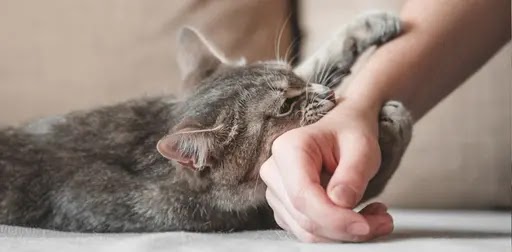Understanding Your Cat's Gentle Nibbles: A Language of Love
If you're a cat owner, you've likely experienced the peculiar yet endearing behavior of your feline friend: the gentle nibble. Unlike a playful or defensive bite, this soft gnawing, often accompanied by purring and kneading, is one of the many ways cats express their affection and trust. But why do cats choose this seemingly odd way to show love? Let's delve into the world of feline behavior and understand the nuances of the gentle nibble in the complex language of cats.
The Language of Love in the Feline World:
Cats communicate through various channels, from vocalizations like meowing and purring to physical gestures such as rubbing and head-butting. Nibbling, often referred to as 'love bites,' is another layer of this intricate communication system. These gentle nibbles are not aggressive; instead, they mimic social grooming or allogrooming, where cats groom each other to strengthen social bonds. When your cat nibbles on you, they're extending this social gesture, treating you as a trusted member of their family.
Decoding the Gentle Nibble:
Social Bonding: Cats engage in mutual grooming to reinforce social structures and express affection. When your cat nibbles you, they're acknowledging you as part of their trusted social circle.
Marking Their Territory: Cats have scent glands around their mouths, so nibbling is a way of marking you with their scent, claiming you as their own in the most affectionate manner.
Seeking Attention: Sometimes, a gentle nibble is your cat's way of saying, "Hey, pay attention to me!" It can be a request for play, petting, or simply a desire for your company.
Weaning Behavior: Kittens nibble on their mother while nursing, and if your cat was weaned early or bottle-fed, they might retain this nibbling behavior as a comforting habit, associating it with care and affection.
Stimulus Response: Cats are sensitive to touch and might nibble in response to a particular spot you scratch or pet, triggered by pleasure or overstimulation.
Nibbling vs. Biting: Knowing the Difference:
It's crucial to differentiate between a gentle nibble and a bite. A nibble is soft, controlled, and doesn't break the skin, often accompanied by other affectionate behaviors. A bite, on the other hand, can be harder, may cause discomfort or injury, and is usually a sign of overstimulation or distress. Understanding your cat's body language and signals can help you distinguish between these behaviors and respond appropriately.
Fostering a Positive Nibbling Experience:
While gentle nibbles are generally harmless and affectionate, not everyone enjoys this behavior. If you prefer your cat to express affection differently, you can gently discourage nibbling by redirecting their attention to a toy or offering a soft verbal cue like "no." Consistency is key in teaching your cat preferred ways to show affection.
When to Seek Advice:
Persistent, aggressive nibbling behavior or nibbling accompanied by other concerning signs might warrant a visit to the veterinarian. Changes in behavior can sometimes indicate underlying health issues, so it's wise to rule out any medical causes.
Nurturing the Bond Through Understanding:
When your cat chooses to nibble on you gently, it's an invitation into their world, a gesture that speaks volumes about the trust and affection they hold for you. To nurture this bond, respond with sensitivity and understanding. Observing how your cat reacts to different interactions can help create a more harmonious relationship where both you and your cat feel understood and respected.
Interpreting the Nibbles: Context Matters:
Context is crucial in interpreting your cat's nibbling behavior. Whether it occurs during a petting session, as a greeting when you return home, or in other situations, paying attention to the context and your cat's overall body language can provide insights into their emotional state and needs.
Encouraging Positive Behaviors:
Positive reinforcement is key if you're keen on modifying your cat's nibbling behavior. Encourage alternative behaviors, such as using a toy or a scratch pad, to provide your cat with other ways to express affection and excitement.
Regular Health Check-Ups:
Regular health check-ups are essential for maintaining your cat's overall well-being, which affects their behavior. Changes in behavior, including an increase in nibbling, can sometimes signal health issues. Ensuring your cat has a balanced diet, regular veterinary care, and a stimulating environment contributes to their physical and emotional health, fostering more balanced and positive behaviors.
Understanding your cat's gentle nibbles goes beyond recognizing it as a quirky behavior—it's a form of communication, a language of love spoken in soft, affectionate gestures. By deciphering this language and responding with care, you strengthen the bond with your feline companion, fostering a relationship built on trust, understanding, and mutual affection.





.png)
.png)


0 Comments